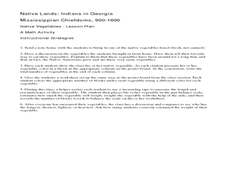Curated OER
Geometric Shapes: Shapes in Everyday Items
Which item is shaped like a cone? Use this multiple-choice shape recognition worksheet to give students access to shapes in their everyday life. Four questions ask scholars to identify which of the pictured items is shaped like a sphere,...
Illustrative Mathematics
Counting Overview
Develop automatic, meaningful counting skills with your class by using everyday classroom/school items, objects, and opportunities. Counting skills should be practiced during the year using objects and items they are familiar with and...
Curated OER
Life Skill Communication
Students use digital camera to document the needs for daily living. In this life skills and visual arts lesson, students create class books that include photographs of everyday objects that they use in their home, school and...
Curated OER
Find the Shapes in a Picture
Use coloring to remind young learners that geometry is all around them! A simple image of a house, sun, and tree becomes the format for several basic shapes. The instructions direct scholars to trace and color each shape using a...
Super Teacher Worksheets
Solid Figures
In the hustle and bustle of everyday life it's easy to forget that geometric shapes are everywhere in the world around us. As they complete this shape identification worksheet, young mathematicians realize that many common real-life...
Curated OER
Mirror, Mirror on the Wall, Who Needs Math in Life at All?
Students think and talk about the ways in which they use math throughout the day. They add each way to a "math in real life" bulletin board and reflect in writing on the ways they use math.
Curated OER
Telling Time as an Everyday Use of Numbers
How can we estimate time? Have your young mathematicians make a clock. Then they compare and contrast types of clocks. They practice writing times in two different ways and make a book about telling time.
Curated OER
Math Investigations
Students brainstorm how math is used in daily life. They develop a class list of different topic areas in which math is used and
work in small groups to think of specific examples of how math is an important part of their lives.
Curated OER
Problem-Solving Math 1
Students discuss the different ways we use numbers in everyday life. They walk around the classroom for 5 to 10 minutes, students are asked to point out examples of numbers they find in the room. Students are asked to image a world...
Curated OER
Magician Squares
Elementary school learners investigate the attributes of a square. They discover that squares are polygons and examine squares found in everyday life. They concentrate on connecting the word, square, with the shape. As an...
Curated OER
Everyday Math
Students discuss word problems involving time and money. In this mathematics instructional activity, students solve word problems as a class focusing on addition, subtraction, multiplication, and simple fractions. Students then make...
Curated OER
An Introduction to Simple Machines
Students investigate simple machines and their uses in everyday life. In this scientific method instructional activity, students examine physical tools such as wedges, screws, and levers using a "how does it work" approach....
Curated OER
Guesstimate? NO Estimate!
Students discover the advantage of estimation over simple guessing using number relationships. They also discover how useful a mathematical tool estimation is in everyday life.
Curated OER
How often do you play tennis?
In this length of time worksheet, students pick lengths of time that describe how often they participate in certain activities in their life. Students fill in the blank for 10 activities.
Curated OER
Native Lands: Indian in Georgia
Students bring in vegetables that the Native Americans ate. In this vegetable lesson, students create a graph that shows how many students brought in each vegetable. They measure their vegetable to find the length, circumference, and...
Curated OER
"Reviewing Facts Through 10" Lesson Plan
Explore the joy of math with you little learners! They practice creating math problems with numbers from a fact family using numbers 1-10. They work independently with a set of connecting cubes to aid them in creating number sentences...
Baylor College
Need or Want?
Even as adults it can be hard to distinguish needs from wants. Using pictures of common, everyday items, children make a pocket chart separating the objects they need from those that they want. Discuss their choices, explaining that...
Curated OER
Design Patterns
Young scholars extend and create patterns. Through a variety of activities, they discover patterns as they exist in math and their everyday lives. Students create a necklace that represents a pattern.
Curated OER
Can You Count on Cans?
How can a canned food drive be connected to math? It's as simple as counting and organizing the cans! Children demonstrate their ability to sort non-perishable foods into categories that include soup cans, vegetable cans, boxed items,...
Curated OER
Representing and Extending Patterns
Young scholars explore repeating and growing patterns. In this patterns lesson, students describe patterns, explore changing patterns and match patterns. Young scholars participate in online activities and read books that show...
Curated OER
Part Part Whole
First graders solve number sentences. In this problem solving activity, 1st graders construct addition sentences using a part part whole mat. Students demonstrate problem solving strategies using cubes.
Curated OER
Pizza Party
Students explore the concept of fractions through use of hands on activity. For this lesson about fractions, students will work together in small groups with a round piece of paper, or pizza, and cut the pizza into pieces. Students will...
Curated OER
Reviewing Facts Through 10
Manipulatives are always fun for children to use. They use connecting cubes and blocks to solve addition and subtraction word problems with numbers up to 10. They then play a math game and use their cube to create number sentences....
Curated OER
How to Reason
Students practice their logical thinking skills. For this reasoning lesson, students complete tasks involving geometric shapes, place value, and odd/even numbers.























